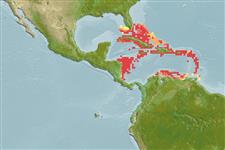>
Holocentriformes (Squirrelfishes, soldierfishes) >
Holocentridae (Squirrelfishes, soldierfishes) > Holocentrinae
Etymology: Neoniphon: Greek, neos = new + Greek, niphon = to snow (Ref. 45335).
More on author: Cuvier.
Environment: milieu / climate zone / depth range / distribution range
पारिस्थितिकी
समुद्री प्रवाल-भित्ति संयुक्त; गहराई सीमा 1 - 70 m (Ref. 9710), usually 30 - 60 m (Ref. 9710). Tropical; 27°N - 10°N, 85°W - 60°W
Western Atlantic: Florida Keys, USA and Bahamas to Trinidad. Antilles and throughout Caribbean (Ref. 26938).
आकार / वज़न / Age
Maturity: Lm ? range ? - ? cm
Max length : 18.0 cm TL पुल्लिंग / अलिंग; (Ref. 26340)
पृष्ठीय रीढ़ (सम्पूर्ण) : 11; पृष्ठीय सौफट रेज़ (सम्पूर्ण) : 12 - 14; गुदा कांटा: 4; ऐनल सौफट रेज़: 9. Body striped with red, yellow and silver; often anterior third of body more yellow than remainder. Third anal ray spine very long and stout (Ref. 26938). Body slender, spiny dorsal fin with broad yellow band along middle and lower sides (Ref. 37108).
Rarely found in shallow water, but appears to be the most common squirrelfish in the depth range of 30-60 m or more (Ref. 32). Reported used as food fish (Ref. 37108).
Life cycle and mating behavior
Maturities | पुनरुत्पत्ति | Spawnings | Egg(s) | Fecundities | लार्वा
Böhlke, J.E. and C.C.G. Chaplin, 1993. Fishes of the Bahamas and adjacent tropical waters. 2nd edition. University of Texas Press, Austin. (Ref. 5521)
IUCN Red List Status (Ref. 130435)
Threat to humans
Harmless
Human uses
मात्स्यिकी: लघु वाणिज्य
साधन
Special reports
Download XML
इंटरनेट स्रोत
Estimates based on models
Preferred temperature (Ref.
123201): 23.7 - 27.7, mean 26.6 °C (based on 29 cells).
Phylogenetic diversity index (Ref.
82804): PD
50 = 0.5312 [Uniqueness, from 0.5 = low to 2.0 = high].
Bayesian length-weight: a=0.01549 (0.00736 - 0.03261), b=2.97 (2.80 - 3.14), in cm total length, based on LWR estimates for this (Sub)family-body shape (Ref.
93245).
Trophic level (Ref.
69278): 3.6 ±0.4 se; based on diet studies.
लौटाव (Ref.
120179): ऊंचा, न्यूनतम जनसंख्या दुगनी समय अवलागत 15 महीने। (Preliminary K or Fecundity.).
Fishing Vulnerability (Ref.
59153): Low vulnerability (10 of 100).
Nutrients (Ref.
124155): Calcium = 82.3 [37.2, 256.7] mg/100g; Iron = 0.795 [0.331, 1.616] mg/100g; Protein = 18.5 [17.3, 19.7] %; Omega3 = 0.18 [0.07, 0.43] g/100g; Selenium = 36.2 [21.2, 69.5] μg/100g; VitaminA = 76.3 [29.6, 206.6] μg/100g; Zinc = 1.5 [1.0, 2.3] mg/100g (wet weight);
